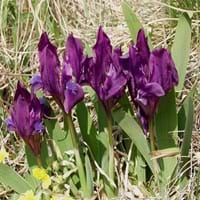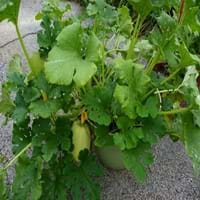Life Span
Perennial
Annual and Perennial
Origin
Eastern Europe
North America, Mexico, Central America
Types
Not Available
Not available
Habitat
Terrestrial
Scrubs, Shores of rivers or lakes
USDA Hardiness Zone
4-9
9-11
Sunset Zone
1a, 1b, 2a, 2b, 3a, 3b, 4, 5, 6, 7, 8, 9, 10, 11, 12, 13, 14, 15, 16, 17, 18, 19, 20, 21, 22, 23, 24
A1, A2, A3, H1, H2, 1a, 1b, 2a, 2b, 3a, 3b, 4, 5, 6, 7, 8, 9, 10, 11, 12, 13, 14, 15, 16, 17, 18, 19, 20, 21, 22, 23, 24
Habit
Clump-Forming
Vining/Climbing
Flower Color
Yellow, Lavender, Blue Violet
Yellow, Orange, Dark Green
Flower Color Modifier
Bicolor
Bicolor
Fruit Color
Not Available
White, Yellow, Green, Orange, Dark Green
Leaf Color in Spring
Green, Sea Green
Green, Dark Green
Leaf Color in Summer
Green, Sea Green
Green, Dark Green
Leaf Color in Fall
Green, Sea Green
Green, Dark Green
Leaf Color in Winter
Light Green
Not Available
Leaf Shape
Lanceolate
Heart-shaped
Plant Season
Spring, Summer
Summer, Fall
Sunlight
Full Sun, Partial Sun
Full Sun
Growth Rate
Medium
Very Fast
Type of Soil
Loam, Sand
Loam, Sand
The pH of Soil
Neutral
Neutral
Soil Drainage
Well drained
Well drained
Bloom Time
Spring, Late Spring, Early Summer
Indeterminate
Tolerances
Drought
Drought
Where to Plant?
Ground
Ground
How to Plant?
By dividing rhizomes, tubers, Seedlings
Seedlings
Plant Maintenance
Medium
Medium
Watering Requirements
Average Water Needs, Do Not over Water
Keep ground moist, Keep the Soil well drained, Requires regular watering
In Summer
Lots of watering
Lots of watering
In Spring
Moderate
Moderate
In Winter
Average Water
Average Water
Soil Type
Loam, Sand
Loam, Sand
Soil Drainage Capacity
Well drained
Well drained
Sun Exposure
Full Sun, Partial Sun
Full Sun
Pruning
Remove damaged leaves, Remove dead branches, Remove dead leaves
Prune in the growing season, Prune to stimulate growth, Remove damaged leaves, Remove dead branches, Remove dead leaves
Fertilizers
All-Purpose Liquid Fertilizer
All-Purpose Liquid Fertilizer
Pests and Diseases
Red blotch
Not Applicable
Plant Tolerance
Drought
Drought
Flower Petal Number
Single
Single
Foliage Texture
Coarse
Coarse
Foliage Sheen
Matte
Matte
Attracts
Hummingbirds
Butterflies, Caterpillar, Flying insects, Insects, Small mammals
Allergy
Skin irritation
Not Available
Aesthetic Uses
Showy Purposes
Showy Purposes
Beauty Benefits
Not Available
Not Available
Environmental Uses
Air purification
Air purification
Medicinal Uses
No Medicinal Use
Nutrients, Rheumatism, Swelling
Part of Plant Used
Not Available
Fruits
Other Uses
Used as Ornamental plant
Sauces, Used as favourite late summer fruits, Used As Food
Used As Indoor Plant
No
No
Used As Outdoor Plant
Yes
Yes
Garden Design
Alpine, Edging, Mixed Border, Rock Garden, Wall
Edible, Herb / Vegetable, Vine
Botanical Name
IRIS pumila
CUCURBITA pepo 'Tivoli'
Common Name
Dwarf Iris
Spaghetti Squash
In Hindi
Dwarf Iris
स्पेगेटी स्क्वैश
In German
Zwergiris
Spaghettikürbis
In French
Dwarf Iris
Courge spaghetti
In Spanish
Enano Iris
स्पेगेटी स्क्वैश
In Greek
νάνος Ίρις
σπαγγέτι Σκουός
In Portuguese
Dwarf Iris
Spaghetti Squash
In Polish
Dwarf Iris
Dynia makaronowa
In Latin
Iris Dwarf
T INLIDO
Phylum
Magnoliophyta
Tracheophyta
Class
Liliopsida
Magnoliopsida
Order
Liliales
Cucurbitales
Family
Iridaceae
Cucurbitaceae
Clade
Angiosperms, Monocots
Angiosperms, Eudicots, Rosids
Tribe
Irideae
Cucurbiteae
Subfamily
Iridoideae
Cucurbitoideae, Not Available
Number of Species
Not Available
Season and Care of Dwarf Iris and Spaghetti Squash
Season and care of Dwarf Iris and Spaghetti Squash is important to know. While considering everything about Dwarf Iris and Spaghetti Squash Care, growing season is an essential factor. Dwarf Iris season is Spring and Summer and Spaghetti Squash season is Spring and Summer. The type of soil for Dwarf Iris is Loam, Sand and for Spaghetti Squash is Loam, Sand while the PH of soil for Dwarf Iris is Neutral and for Spaghetti Squash is Neutral.
Dwarf Iris and Spaghetti Squash Physical Information
Dwarf Iris and Spaghetti Squash physical information is very important for comparison. Dwarf Iris height is 10.20 cm and width 15.20 cm whereas Spaghetti Squash height is 60.00 cm and width 90.00 cm. The color specification of Dwarf Iris and Spaghetti Squash are as follows:
Dwarf Iris flower color: Yellow, Lavender and Blue Violet
Dwarf Iris leaf color: Green and Sea Green
Spaghetti Squash flower color: Yellow, Orange and Dark Green
- Spaghetti Squash leaf color: Green, Dark Green
Care of Dwarf Iris and Spaghetti Squash
Care of Dwarf Iris and Spaghetti Squash include pruning, fertilizers, watering etc. Dwarf Iris pruning is done Remove damaged leaves, Remove dead branches and Remove dead leaves and Spaghetti Squash pruning is done Prune in the growing season, Prune to stimulate growth, Remove damaged leaves, Remove dead branches and Remove dead leaves. In summer Dwarf Iris needs Lots of watering and in winter, it needs Average Water. Whereas, in summer Spaghetti Squash needs Lots of watering and in winter, it needs Average Water.





